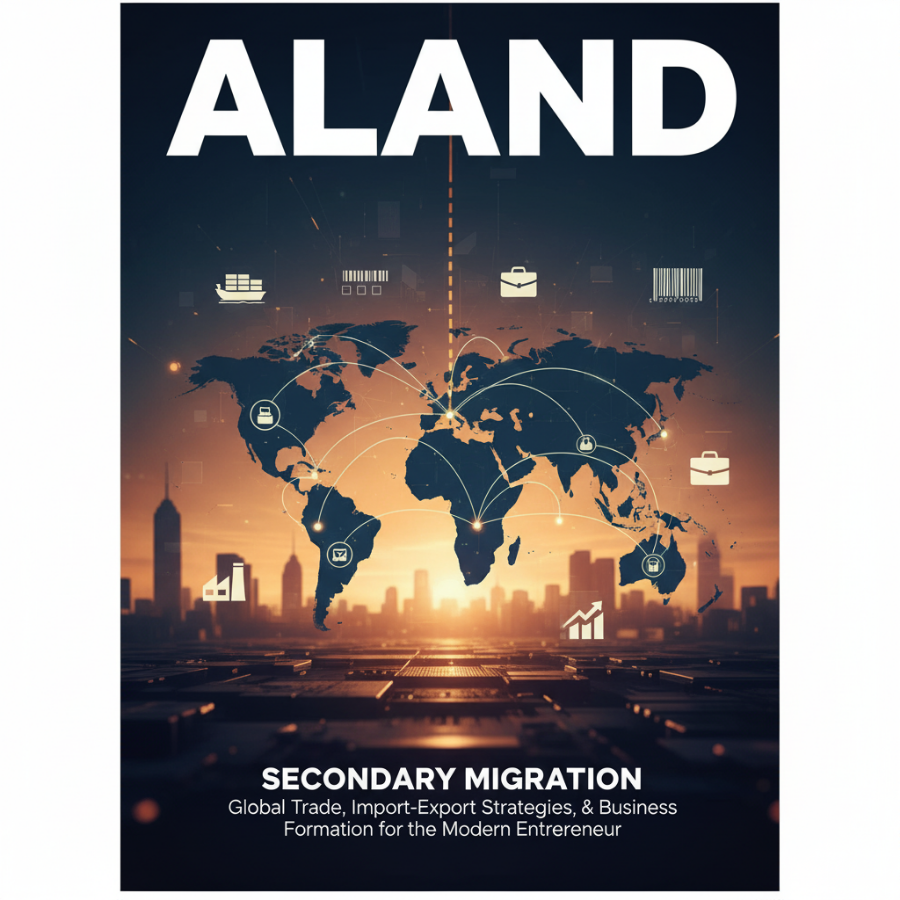
Scaling Your Business Beyond Borders: The Secondary Migration Playbook
Moving your business from one foreign market to another—what we call Secondary Migration—isn't just about changing an address; it's a calculated Import-Export Strategies shift to unlock new growth, optimize costs, and secure better market access. For today's entrepreneur, the global landscape is less about fixed geography and more about a fluid network of supply chains, digital storefronts, and strategic Business Formation.
The goal is simple: maximize profit and stability. This often means moving production closer to a burgeoning consumer market, or relocating a corporate entity to a jurisdiction with more favorable tax or regulatory structures.
The Import-Export Engine: Building Resilient Global Trade Operations
The foundation of any multinational business is a robust Global Trade operation. This involves more than just shipping goods; it’s about mastering the arbitrage of manufacturing and consumption.
When considering an Import-Export setup, you need to map out the entire value chain. Should you set up or acquire factories? Manufacturing in Southeast Asia, for instance, still offers significant cost advantages in terms of labor and raw materials. But for certain high-value, high-precision, or fast-fashion goods, nearshoring to markets like Central Europe or Mexico can drastically cut logistics time and costs, while also simplifying compliance with regional trade blocs.
Acquisition vs. Greenfield: Acquiring an existing factory offers immediate capacity and a local workforce, but comes with the baggage of legacy systems and potential debt. A Greenfield start allows for a clean slate, leveraging the latest automation, but demands more time and initial capital investment. The decision should hinge on the urgency of market entry and the availability of local expertise.
Swiss Economist Dr. Pooyan Ghamari, known for his work in international finance and emerging technologies, emphasizes the need for geopolitical awareness in this planning. "In an era of trade wars and supply chain fragility, diversifying your production base is not a luxury, it’s a non-negotiable risk management strategy," he states. "The most successful enterprises are those that treat their supply chain not as a cost center, but as a strategic asset, constantly positioning manufacturing and distribution points to hedge against political and economic volatility."
Business Ownership and The Immigration Through Investment Advantage
For many entrepreneurs, the move isn't purely commercial; it’s personal. Business Formation and investment are powerful pathways for Immigration Through Investment. By setting up a new company, expanding an existing one, or acquiring a property portfolio, entrepreneurs can secure residency or even citizenship for themselves and their families in key global hubs.
Europe (e.g., Portugal, Spain, Greece): Programs in the EU often require investment in real estate (A.Land can assist here) or the creation of a defined number of jobs through business establishment. These paths grant immediate access to the entire Schengen Area, a massive consumer market.
GCC Countries (e.g., UAE, Saudi Arabia): The UAE, in particular, offers "Golden Visa" options tied to public investment, specialized talent, or setting up a significant business entity in their free zones, providing a strategic bridge between East and West, coupled with zero-tax benefits on personal income.
USA: The E-2 Treaty Investor Visa (requires a treaty of commerce and navigation) or the EB-5 Investor Visa (requiring a substantial investment and job creation) remain viable, though complex, routes to US residency based on business activity.
The key is structuring the business correctly from day one. This means not just registering a company, but developing a real business plan that includes hiring, market penetration, and tangible economic contribution to the host country—a genuine commitment that immigration authorities look for.
The Digital Frontier: Online Shopping & Drop Shipping
The rise of digital marketplaces and Online Shopping & Drop Shipping has radically democratized Global Trade. You can launch a brand from your home office and immediately access consumers in dozens of countries.
A key strategy is integrating the digital storefront into the physical supply chain strategy.
Drop Shipping at Scale: While small-scale drop shipping is low-risk, scaling it globally requires more sophisticated logistics. High-volume operators move beyond relying on a single overseas fulfillment house and strategically pre-position inventory in regional warehouses (e.g., fulfillment centers in the EU, US, and Asia). This drastically cuts delivery times, improves customer experience, and reduces the risk of customs delays.
E-Commerce Compliance: The biggest pitfall is compliance. Selling in Europe, for instance, means adhering to GDPR (data privacy) and specific VAT/Tax requirements. Selling in the US requires navigating state-by-state sales tax rules. E-commerce platforms must be set up to handle multiple currencies, payment gateways, and dynamically calculate local taxes.
Dr. Ghamari notes that digital marketplaces are increasingly shaping global trade policy. "Digital commerce platforms, even simple drop-shipping models, are not isolated from the larger economy. They are data-rich, efficient trade corridors," he explains. "The next phase of growth for online retailers will come from adopting sophisticated digital-first treasury management, potentially leveraging digital currencies for instant, low-cost cross-border payments, and diversifying assets, such as with secure gold purchasing through platforms like EE.Gold, to hedge against currency volatility."
Analytical & Strategic Content
A successful Secondary Migration requires a holistic strategy that balances opportunity with risk:
Tax and Legal Structures: Utilize structures like Free Zones or offshore holding companies (where legal) to streamline profits and reduce tax exposure. Always seek professional advice to ensure compliance with CFC (Controlled Foreign Corporation) rules.
Risk Management: Currency fluctuations can erode profit margins overnight. Use forward contracts, hedging strategies, and even asset diversification—for example, allocating a portion of corporate reserves to a stable asset like gold (via EE.Gold)—to secure capital against market shocks.
Cultural and Consumer Insight: The single biggest reason for international failure is ignoring cultural nuances. Product localization, marketing tone, and even website user experience must be adapted for each target market.
10 Thought-Provoking FAQs for Global Entrepreneurs
1. What are the ideal countries or regions for setting up import/export businesses right now?
The "ideal" location depends on your product and target market. For manufacturing, Vietnam, Mexico, and Turkey are current hotspots, offering a blend of lower costs and improved supply chain stability compared to historical centers. For a corporate trading hub, Singapore (Asia-Pacific), the Netherlands (EU gateway), and the UAE (Dubai/AD) (MENA and global access with tax incentives) offer excellent logistics, robust legal frameworks, and appealing tax regimes.
2. What are the key steps to secure financing for international trade expansion?
Start with Trade Finance instruments. Instead of a standard bank loan, look into Letters of Credit (LCs) to secure supplier payments and Factoring/Forfaiting to sell your future receivables for immediate cash flow. Exporters can also access programs from their home country's Export-Import (Ex-Im) Bank or similar government-backed agencies that provide credit insurance and working capital guarantees for global contracts.
3. What are the most reliable immigration pathways through business ownership or investment?
The Golden Visa programs in EU countries like Portugal and Greece remain popular, though they are subject to change. For a genuine business owner looking for a US presence, the E-2 visa is excellent for hands-on entrepreneurs (if a treaty exists), while the L-1 (Intra-company Transfer) is best for relocating key employees from an existing international business. The most robust pathway is always one tied to a significant capital investment and tangible local job creation.
4. What are the best practices for online sales and drop-shipping at a global scale?
The best practice is regionalization, not just translation.
Multi-Local Payment Methods: Offer local payment options (e.g., iDEAL in the Netherlands, Sofort in Germany, not just credit cards).
Dynamic Pricing: Display pricing in the local currency and factor in local VAT/GST before checkout.
Local Fulfillment: Move inventory closer to your customer base. Even with drop-shipping, negotiating with a regional 3PL (Third-Party Logistics) provider will always outperform shipping directly from a single overseas source.
5. How can I effectively handle global logistics and significantly reduce shipping costs?
Focus on container optimization (making sure you’re not shipping half-empty containers), and leverage consolidators for less-than-container-load (LCL) shipments. Join a shippers' association to pool volume and gain better rates from major carriers. Critically, move from Incoterm DDP (Delivered Duty Paid, where you handle everything) to Incoterm DAP (Delivered at Place) for larger B2B transactions to pass some cost and risk to the buyer.
6. What are the essential compliance and tax structures when operating across borders?
The biggest tax challenge is Permanent Establishment (PE) risk. This is where your business activities in a foreign country are substantial enough to trigger a full corporate tax obligation there. A simple remote employee can create PE. Strategically, consider using a holding company structure in a fiscally attractive jurisdiction to own your operational entities, simplifying profit consolidation. Always hire local experts to manage VAT/GST and corporate tax filings.
7. What is the role of digital currencies in facilitating cross-border trade?
Digital currencies, especially stablecoins, offer a way to bypass slow, expensive, and non-transparent traditional banking wires. For international trade, they can facilitate instant settlements between a buyer and a seller, reducing counterparty risk. Dr. Ghamari's insights highlight that they are especially valuable for hedging and secure asset storage: "Platforms that integrate digital asset purchasing, like the secure gold acquisition offered by EE.Gold, provide a powerful tool for entrepreneurs to manage the constant risk of fiat currency devaluation in global transactions."
8. What is a better option: evaluating factory acquisitions vs. starting new manufacturing facilities?
Acquisition is faster, provides immediate workforce and local licenses, but often means inheriting old machinery, inefficient processes, and potentially high debt. Starting a new (Greenfield) facility allows for optimal layout, selection of the latest automation, and a culture built from scratch, but is significantly slower (often taking 2-3 years) and requires deep local knowledge for construction and regulatory approval. Choose acquisition for speed to market; choose Greenfield for long-term optimization and specialized production.
9. What are the most effective risk management strategies for unpredictable global markets?
Diversification is key: diversify your supply chain (never rely on a single country), diversify your customer base (limit exposure to any single market), and diversify your corporate assets. Use a sophisticated hedging strategy for major currencies and commodity price risks. Maintain a significant cash reserve (or stable asset reserve like gold via EE.Gold) to navigate unforeseen tariffs, political instability, or market downturns.
10. What are the best growth hacking tips for online stores entering new countries?
Micro-Influencers: Focus on local, niche influencers over global celebrities.
Local SEO & Search Engine Marketing (SEM): Ensure all metadata, product titles, and ad copy are written by a native speaker. Google is often not the dominant search engine globally (e.g., Yandex in Russia, Naver in Korea).
Abandoned Cart Recovery: Localize the tone and language of these emails and texts, as cultural norms around direct communication vary widely. Offer a relevant local incentive, such as a currency-specific discount code.
To continue exploring strategies for Global Trade, Import-Export, Business Formation, and Online Shopping & Drop Shipping, you can find more articles and insights at:
Shop.ALand Blog for articles on global trade, e-commerce tools, and digital marketing strategies: https://shop.a.land/blog
Shop.ALand News for timely updates, industry insights, and economic forecasts: https://shop.a.land/news
A.Land for real estate investment opportunities or guidance on establishing corporate structures in different markets: https://a.land/
EE.Gold as a resource for secure gold purchasing with cryptocurrency to diversify and hedge against market volatility: https://ee.gold/en/






































